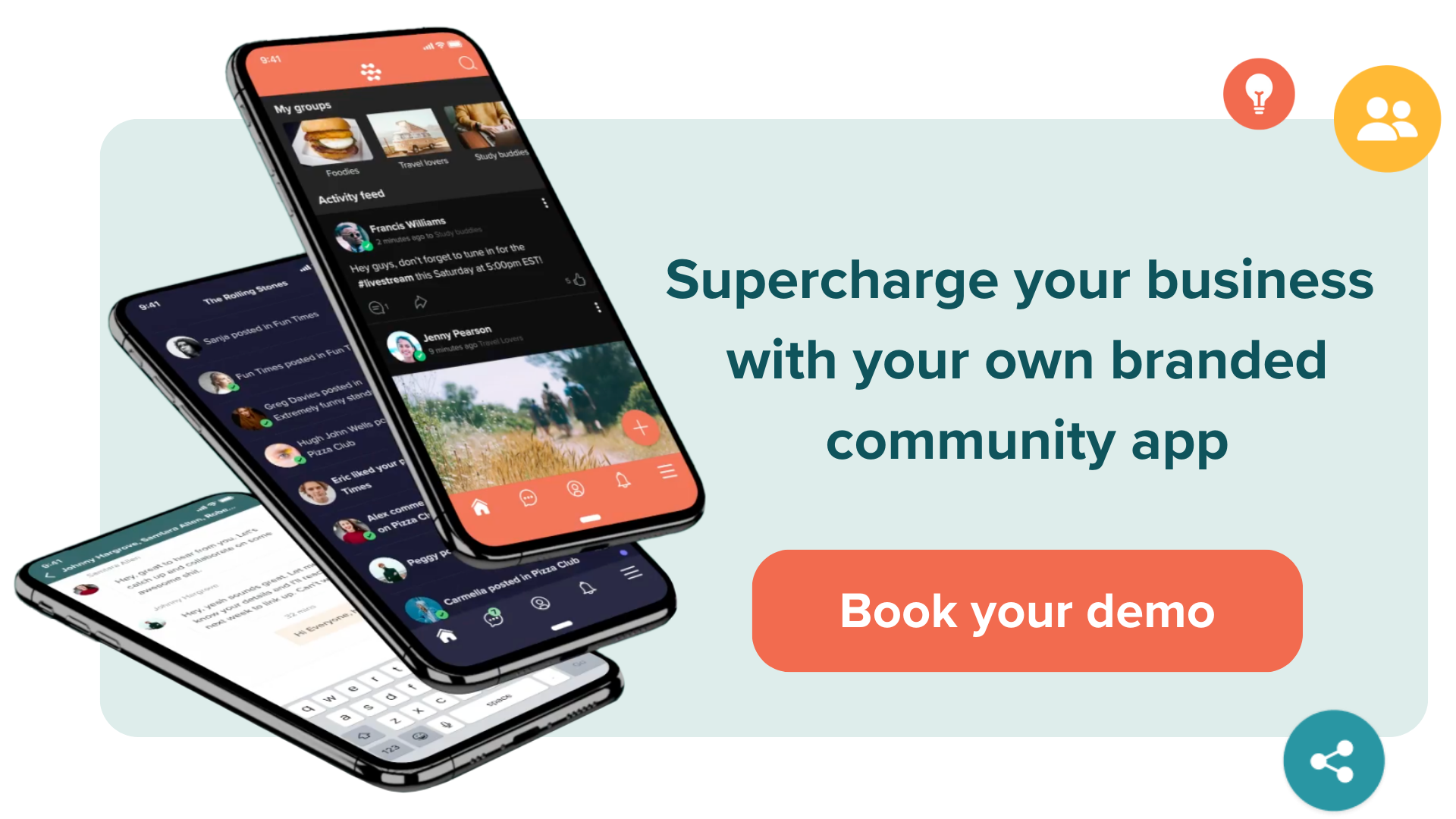Filter by Category
Filter by Category
Contents
For businesses seeking to foster deep connections and brand loyalty in today’s digital landscape, establishing a paid community has become a pivotal strategy for knowledge sharing and purposeful networking. Here, we’ll guide you step-by-step on how to nurture such a valuable space for your business.
What is a paid community?
A paid community is more than just a forum or group with a subscription fee. It represents a curated experience, a space where individuals pay not just for access, but for enhanced value, exclusivity, and a sense of belonging. This could manifest as content, coaching, networking or myriad other forms of value.
A paid community is the antithesis of the vast, often chaotic world of open online forums or public social media platforms. In your paid community, noise is filtered, discussions are more intentional, and value is heightened.
Benefits of paid communities
In today’s digital age, where free content and communities are found everywhere, opting for a paid model might seem challenging. However, the huge benefits of curating a paid community can’t be overlooked, especially when seeking a profound connection with a dedicated audience. Here are some standout benefits:
- Controlled environment: For community hosts and organizers, a paid model offers unparalleled control over the community’s direction, culture, and norms. This ensures a tailored, brand-aligned experience, allowing for a community space that truly resonates with its members.
- Safety and privacy: In an age where data breaches and privacy concerns are rampant, paid communities often offer a safer haven. With stricter controls, dedicated support, and more invested members, the community is naturally more protected from toxic behaviour often found online.
- Direct revenue stream: This isn’t just about monetization; it’s about mutual trust. A consistent revenue stream not only ensures a community’s financial sustainability but also underscores the perceived value by its members, reinforcing its longevity and stability.
- Increased engagement: There’s an unwritten commitment that comes with financial investment. Members of paid communities are more likely to engage actively, contribute valuable insights, and foster a thriving environment. This deeper connection leads to a lively, dynamic community space.
- High-quality discussions: The paid barrier filters out passive or disruptive elements, ensuring that interactions remain constructive. Members tend to be more serious, discussions more insightful, and the overall discourse becomes richer, offering genuine value to every participant.
- Exclusivity and prestige: A paid community often carries a badge of exclusivity. Members not only get access to specialized content but also join a league of dedicated individuals, creating a sense of prestige and belonging.
- Enhanced support and features: With a dedicated revenue stream, hosts can reinvest into the community, be it in the form of high-quality content, advanced features, or personalized support. This continuous improvement ensures that the community remains fresh, updated, and ahead of the curve.
In essence, while the idea of a paid community might require an initial leap of faith, the multifaceted benefits it offers – both to hosts and members – make it a compelling model for anyone looking to build a meaningful, impactful, and sustainable online community.

Identify your target audience
For a thriving paid community, understanding your target members is paramount. Here’s a roadmap to sync your community’s offerings with your audience’s desires:
- Define your niche: Clearly pinpoint your community’s focus, the more niche the better. At Disciple, we host extremely successful communities on all sorts of niche topics, including knitting and railway modelling. Your niche is your key to creating a tight knit community that your members will love. This guides content creation, engagement strategies, and even aesthetics.
- Understand pain points: Dive into the specific challenges your audience faces. For instance, if catering to knitters, addressing difficulties in sourcing sustainable materials or mastering intricate patterns could be a draw.
- Recognize aspirations: Beyond challenges, what are your members’ ambitions? Catering to budding authors? Offering workshops on manuscript drafting could be invaluable.
- Utilize analytical tools: Platforms like Disciple Media offer rich analytics. Examine member behaviors and preferences to refine the user experience continually.
- Engage with purpose: Maintain a structured engagement calendar. Use surveys, polls, and Q&A sessions to ensure your community adapts to evolving needs.
- Foster open communication: Maintain channels for members to share experiences, suggest content, and collaborate, enhancing organic growth and community diversity.
- Monitor external trends: Stay updated with broader trends in your niche, ensuring your community remains current and relevant.
With astute insights, strategic engagement, and a pulse on trends, your paid community can become a vital hub, ensuring it resonates deeply with its members and continues to grow.
Define your unique selling point (USP)
In today’s interconnected world, a myriad of online communities exist. To rise above the noise and genuinely connect, you need a compelling USP. Here’s how to craft a magnetic appeal:
- Exclusive offerings: Does your community host exclusive webinars, masterclasses, or courses unavailable elsewhere? Offering niche content, especially if it’s tailor-made based on members’ feedback, can significantly boost appeal.
- Access to thought leaders: Membership could mean direct consultations or Q&A sessions with industry experts or influencers. This insider access can be a game-changer for professionals or enthusiasts. Many successful paid communities are centred around the host – your own expertise and personality may be a key part of your USP.
- Unique resources: Consider tools, templates, or e-guides exclusive to your community. If you’re catering to marketers, perhaps an evolving toolkit of the latest marketing strategies. For fitness enthusiasts, maybe a personalized workout regime.
- Community culture: Beyond tangible resources, the camaraderie, supportive environment, and culture can be a massive USP that your competitors simply can’t replicate. If members find mentors, collaborators, or friends within your community, their loyalty deepens.
- Tailored experiences: With platforms like Disciple Media, you can offer personalized experiences based on user behavior and preferences, making their journey within the community more engaging and fulfilling.
- Continuous adaptation: An evolving USP keeps pace with changing member aspirations. Regularly solicit feedback and be agile in tweaking your offerings to stay ahead of the curve.
Your USP isn’t just a marketing tool; it’s the very essence of what you offer. It’s a promise of value, a commitment to continuous growth, and a testament to how deeply you understand and cater to your audience’s needs.

Choose the right platform
Picking the right platform is more than just features; it’s about synergy between the platform’s offerings and your community’s objectives. Nowadays there are some fantastic off-the-shelf options that cost significantly less than custom development and still provide good customization. Here’s a closer look at what you should look for when choosing a platform provider:
- Branding and customization: Your platform should allow your brand to shine, be it through colors, logos, or overall theme. With Disciple, not only can you showcase your brand on mobile and web apps, but you can also organize your content with folders and groups, offering a unique and structured experience.
- Mobile app: A mobile app is vital for providing an experience that people will pay for in 2023. Disciple Media is the only mobile-first community platform provider, offering slick mobile apps that will elevate your business.
- User experience: Ensuring an intuitive navigation is non-negotiable. Platforms like Disciple champion a clean design, creating spaces that feel familiar and trustworthy to members, promoting engagement.
- Data control and security: Trust is paramount. Platforms should adhere to the highest data protection standards. With Disciple, you get full data control, ensuring content is directly shared with members without third-party interference.
- Robust management tools: Features like powerful analytics, as offered by Disciple, allow you to tap into community behaviors and trends, refining your strategies and enhancing member experiences.
- Engagement features: The goal is genuine connections. Disciple offers chat options ranging from personal discussions to group chats, hosts courses to enrich the community experience, and employs push notifications, ensuring members are in the loop.
- Monetization capabilities: Look for platforms that support various revenue models. Disciple simplifies this with features like subscriptions and in-app purchases, allowing communities to provide exclusive content and tiered offerings.
- Setup and usability: The faster and more intuitive, the better. Disciple, for instance, offers a swift setup, with an app ready in just days. Plus, its interface is logical, simplifying membership management and integrating existing tools.
In summary, when choosing a platform like Disciple, you’re not just opting for features, you’re embracing an ethos: simplicity, transparency, and complete control. Your platform should not only align with your present needs but should be scalable for your community’s future aspirations.
Set a pricing model
In a paid community, determining how to price your offering is more art than science. It’s about striking the right balance between the value you provide and what your audience is willing to pay. Here’s how to go about it:
- Value assessment: Begin by comprehensively understanding the value you’re offering. Are you providing exclusive content, tools, courses, or direct access to experts? Assess the tangible and intangible benefits members receive.
- Competitive analysis: Take a look at similar communities in your niche. While you shouldn’t directly mimic others, understanding the market standard gives you a starting point.
- Tiered offerings: Consider multiple membership levels. Platforms like Disciple allow for subscription-based models where you can offer basic to premium memberships. This caters to various audience segments, from those testing the waters to committed members looking for comprehensive benefits.
- Freemium model: Offering a basic free membership with options to upgrade to access exclusive content can be a great way to give potential members a taste of your community, nudging them towards a paid subscription.
- In-app purchases: Another model to consider, especially if you’re using platforms like Disciple, is to offer in-app purchases. This allows members to pay for exclusive content or features on an as-needed basis, offering flexibility.
- Regular re-evaluation: It’s essential to periodically reassess your pricing model. As your community evolves, the value you offer will change, and so should your pricing. Feedback from members can be invaluable here.
- Transparency: This can’t be stressed enough. Ensure that your pricing, irrespective of its complexity, is transparent. Hidden fees or sudden changes can erode trust, undermining the community’s stability.
Ultimately, your pricing model should reflect the value you’re offering while ensuring the sustainability of the community. It should be agile, ready to evolve with changing circumstances, and always centered on member trust and satisfaction.

Market your community
Marketing a paid community involves more than just traditional tactics; it’s about establishing genuine connections and showcasing value. Here’s a guide to effectively market your community:
- Understand your audience: As discussed above, it begins here. What are their pain points? Interests? Aspirations? By deeply understanding them, you can tailor your marketing messages to resonate and motivate action.
- Content marketing: Share valuable content related to your community’s niche. This could be blog posts, videos, or podcasts. The goal is to showcase expertise, establish trust, and attract potential members.
- Social media engagement: Use platforms like Facebook, Instagram, or LinkedIn to interact with your target audience. Share community highlights, testimonials, or insights, offering a sneak peek into what members gain.
- Leverage existing members: Word-of-mouth is gold. Encourage your community members to share their experiences, maybe through a referral program. Authentic testimonials can be a potent marketing tool.
- Webinars and live sessions: Host informative sessions about topics relevant to your community. At the end, give a brief introduction to your community and its benefits.
- Email marketing: Reach out to your existing subscriber base. Share updates, success stories, or insights from your community. Consider special offers or trials to entice them to join.
- Collaborations: Partner with influencers or experts in your niche. They can provide valuable content, workshops, or sessions exclusive to your community, enhancing its appeal.
- Feedback loop: Always keep the communication channels open. Understand what’s working and what’s not. Use this feedback to fine-tune your marketing strategies.
Remember, marketing your community isn’t a one-time task. It’s a continuous effort to showcase value, foster connections, and grow your member base. While the strategies might evolve, the central ethos remains – genuine value, trust, and connection.

Gather feedback and improve
Continuous improvement is the hallmark of a thriving community. Tapping into member feedback is key. Here’s how to effectively gather and leverage it:
- Surveys and polls: Use regular surveys or polls to gauge member satisfaction, understand pain points, and seek suggestions. Keep them short and engaging to ensure higher participation.
- Open channels: Create dedicated spaces within the community where members can openly share feedback or voice concerns. This promotes transparency and trust.
- Analyze behavior: Platforms like Disciple offer powerful analytics. Study user behavior, identify engagement patterns, and adapt your strategies accordingly.
- Iterative approach: Once you receive feedback, act on it. Whether it’s introducing a new feature or refining existing processes, show your members you value their input.
- Feedback recognition: Recognize and appreciate those who provide feedback. This can be done via shout-outs, badges, or even exclusive perks.
- Review sessions: Periodically, host live sessions to discuss the state of the community, upcoming changes, and gather real-time feedback.
Incorporating feedback isn’t just about improvement; it’s about showing members they’re heard and valued. This fosters loyalty and ensures the community stays vibrant and relevant.

Tips and strategies to manage a community
Managing a community, especially a paid one, requires a blend of strategic planning, genuine engagement, and consistent adaptation. Here are tips to help you excel:
- Establish guidelines: Set clear community rules and guidelines. This ensures a safe, respectful space and sets expectations from the get-go.
- Regular engagement: Host events, Q&A sessions, or themed discussions to keep members active and involved. Predictable schedules, like “Weekly Wins Wednesday,” can boost anticipation and participation.
- Recognize contributions: Spotlight members who add significant value, whether through insightful posts, helpful advice, or overall positivity. Recognition fosters a sense of belonging.
- Delegate responsibilities: As your community grows, consider appointing moderators or community champions. They can help maintain the community’s ethos, manage discussions, and ensure guidelines are followed.
- Diverse content: Mix up your content. Videos, articles, infographics, or even quizzes can keep the community experience fresh and engaging.
- Conflict resolution: Address conflicts swiftly and fairly. Having a transparent resolution process helps members trust your management style.
- Stay updated: The world is dynamic. Whether it’s industry news or global events, being updated and facilitating discussions around relevant topics keeps your community contemporary.
Remember, a community thrives on mutual respect, trust, and engagement. Balancing strategic management with genuine connections ensures your community remains vibrant and grows sustainably.
Conclusion
Building a thriving paid online community is both an art and a science. While the foundation lies in understanding your audience and offering them genuine value, the nuances come in seamlessly managing, adapting, and scaling your community based on feedback and ever-evolving member needs. With the right strategies, a touch of personalization, and a platform that provides autonomy and powerful features, you can transform your vision into a vibrant, value-driven community.
Remember, it’s a journey, not a sprint. With patience, persistence, and a member-first approach, you’re well on your way to establishing a paid community that not only serves but flourishes. Whether you’re just beginning or looking to enhance your existing community, the future is full of possibilities for both your business and your members.
FAQs
What is a paid online community?
A paid online community is a digital space where members pay a fee to access exclusive content, discussions, and benefits. These communities often offer specialized knowledge, tools, or interactions not available in free forums.
Why would someone pay to join a community?
Members often seek exclusive content, expertise, or the chance to network with like-minded individuals. They also value the more curated and spam-free environment that often comes with paid memberships.
How do I decide the right price for my community?
Pricing should consider the value you offer, the demographic you target, and competitive rates. Research, pilot pricing models, and feedback can help fine-tune your decision.
How important is the platform choice for my paid community?
Essential. Your platform determines the user experience, the management tools available, and the flexibility to customize. Platforms like Disciple provide a mix of usability and powerful features, making them a popular choice for many hosts.
Can I migrate my existing free community to a paid model?
Yes, but it requires a strategic approach. Communicate the added value members will receive, offer early bird discounts, or grandfather existing loyal members into the new model.
How can I ensure high engagement in my paid community?
Regular, valuable content, engaging events, member recognition, and a feedback-driven approach are key. Also, using platforms that offer robust analytics can help understand and boost engagement patterns.
What if my paid community doesn’t pick up traction initially?
Building a successful community often takes time. Continue marketing, refining your USP, engaging with early members, and gathering feedback for improvements. Persistence and adaptability are crucial.
See how a Disciple community
can fit your business needs
See how a Disciple community can fit your business needs
Related Articles
18 min read
How To Build Your Online Community From Scratch
Wondering how to create a community? How to turn your social media presence into a thriving online community? …
8 min read
How the Best Businesses Build Brand Communities (+Examples)
No matter the name of your brand, the industry you operate in, the products you make or the …
9 min read






